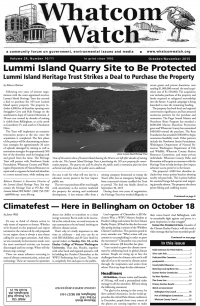by Beverly Alder
The Federal Communications Commission (FCC) and Industry Canada have requirements that mandate the placement of radio antennas a safe distance from populated areas.
So it came as a surprise that BBC Broadcasting Inc., holders of the license to broadcast KRPI AM 1550, was able to obtain a construction permit from the FCC to build five 150-foot radio antennas and to increase their signal to the maximum allowed — 50,000 watts. These proposed towers would be sited in Point Roberts, a mere 1000 feet from the U.S./Canadian border and the densely populated Canadian community of Tsawwassen, B.C., home of 23,000 people.
How was this allowed to happen? In its application to the FCC, Tsawwassen was redacted from the supplied maps. Ladner was represented the closest town 7.2 miles from the border. Tsawwassen, which sits immediately on the border was presented as a vacant land area with no roads, homes or businesses.
Residents of Tsawwassen and Point Roberts are outraged that this travesty and have been fighting it in courts and agencies in both countries. The radio towers will be in the US but they are designed to broadcast northward targeting the South Asian market in Metro Vancouver. There is no economic, social or technological benefit to the residents of Point Roberts or Tsawwassen from the operation of these towers.
There are, however, extreme liabilities to both communities. Businesses must be ethical in their submissions with the governments that regulate them. Government is responsible for protecting the health and welfare of those affected by their operations.
The tower array will generate 50,000 watts of electromagnetic radiation (EMR) on a continuous basis. EMR travels through the air, into the ground and penetrates human tissue. Several recent peer-reviewed articles show that continuous exposure to EMR from high wattage towers produces breaks in the DNA in human cells. The damage is cumulative and, as studies in Korea and Vatican City showed, it increases the risk of cancer, particularly in children.
In May of 2015 over 200 scientists from 40 countries issued an appeal to the United Nations and the World Health Organization to adopt more protective electromagnetic field guidelines. The position paper noted that long-term exposure to EMR produces:
(a) increases in harmful free radicals,
(b) genetic damage,
(c) learning and memory deficits,
(d) changes to the reproductive system,
(e) increased frequency of neurological disorders and
(f) long-term diminution in general well-being. These effects will be felt by the citizens of Tsawwassen and Point Roberts if these towers are built.
There are economic ramifications as well. The proximity of cell and radio towers to populated areas can and will cause drops in real estate values. A report in The New York Times found that these range from 5 percent to 40 percent, depending on the home’s proximity to the towers.
So far, Point Roberts and Tsawwassen are caught in this international travesty. Citizens on both sides of the border do not have confidence in the process, which has been most seriously compromised and lacks legitimacy due to the omission of the most relevant facts.
We call on all appropriate parties, the FCC, Whatcom County officials, Industry Canada and the Washington State Courts to reach just and effective conclusions and make sure that these towers are never permitted to be built.
Beverly Alder, Tsawwassen, B.C.
Arthur S. Reber, Point Roberts




























